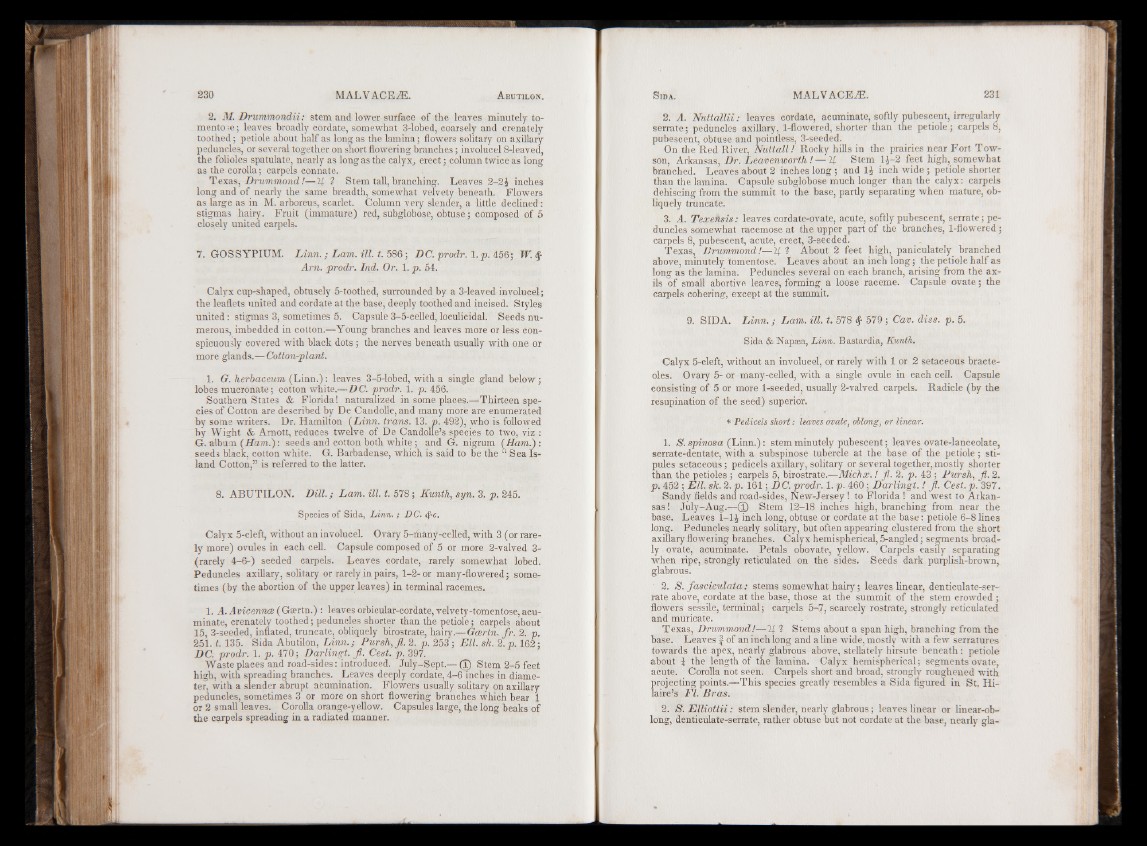
2. M. Drummondii: stem and lower surface of the leaves minutely to-
mentoie; leaves broadly cordate, somewhat 3-lobed, coarsely and crenately
toothed; petiole about half as long as the lamina; flowers solitary on axillary
peduncles, or several together on short flowering branches; involucel 8-leaved,
the folioles spatulate, nearly as long as the calyx, erect; column twice as long
as the corolla; carpels connate.
Texas, Drummond!—11 ? Stem tall, branching. Leaves 2 -2 i inches
long and of nearly the same breadth, somewhat velvety beneath. Flowers
as large as in M. arboreus, scarlet. Column very slender, a little declined:
stigmas hairy. Fruit (immature) red, subglobose, obtuse; composed of 5
closely united carpels.
7. GOSSYPIUM. L in n .; Lam. ill. t. 586; DC. prodr. l.p . 456; W. §
Am. prodr. Ind. Or. 1. p. 54.
Calyx cup-shaped, obtusely 5-toothed, surrounded by a 3-leaved involucel;
the leaflets united and cordate at the base, deeply toothed and incised. Styles
united : stigmas 3, sometimes 5. Capsule 3-5-eelled, loculicidal. Seeds numerous,
imbedded in cotton.—Young branches and leaves more or less conspicuously
covered with black dots ; the nerves beneath usually with one or
more glands.—Cotton-plant.
1. G. herbaceum (Linn.): leaves 3-5-lobed, with a single gland below;
lobes mucronate; cotton white.—DC. prodr. 1 p. 456.
Southern States & Florida! naturalized in some places.—Thirteen species
of Cotton are described by De Candolle, and many more are enumerated
by some writers. Dr. Hamilton (Linn, trans. 13. p. 492), who is followed
by Wight & Arnott, reduces twelve of De Candolle’s species to two, viz :
G. album (Ham.): seeds and cotton both white ; and G. nigrum {Ham.):
seeds black, cotton white. G. Barbadense, which is said to be the “ Sea Island
Cotton,” is referred to the latter.
8. ABUTILON. Dill.; Lam. ill. t. 578; Kunth, syn. 3. p. 245.
Species of Sida, Linn. ; DC. tpc.
Calyx 5-cleft, without an involucel. Ovary 5-many-celled, with 3 (or rarely
more) ovules in each cell. Capsule composed of 5 or more 2-valved 3-
(rarely 4-6-) seeded carpels. Leaves cordate, rarely somewhat lobed.
Peduncles axillary, solitary or rarely in pairs, 1-2- or many-flowered; sometimes
(by the abortion of the upper leaves) in terminal racemes.
1. A. A vicennce (Gsertn.) : leaves orbicular-cordate, velvety-tomentose, acuminate,
crenately toothed; peduncles shorter than the petiole; carpels about
15, 3-seeded, inflated, truncate, obliquely birostrate, hairy.— Gcertn. fr . 2. p.
251. t. 135. Sida Abutilon, Linn.; Pursh,Jl. 2. p. 253 ; Ell. sk. 2. p. 162;
DC. prodr. 1. p. 470; Darlingt. fl. Cest. p. 397.
Waste places and road-sides: introduced. July-Sept.— (X) Stem 2-5 feet
high, with spreading branches. Leaves deeply cordate, 4-6 inches in diameter,
with a slender abrupt aeumination. Flowers usually solitary on axillary
peduncles, sometimes 3 or more on short flowering branches which bear 1
or 2 small leaves. Corolla orange-yellow. Capsules large, the long beaks of
the carpels spreading in a radiated manner.
2. A. Nuttallii: leaves cordate, acuminate, softly pubescent, irregularly
serrate; peduncles axillary, 1-flowered, shorter than the petiole; carpels 8,
pubescent, obtuse and pointless, 3-seeded.
On the Red River, Nuttall! Rocky hills in the prairies near Fort Tow-
son, Arkansas, Dr. Leavenworth ! — If Stem l }-2 feet high, somewhat
branched. Leaves about 2 inches long ; and l i inch wide ; petiole shorter
than the lamina. Capsule subglobose much longer than the calyx: carpels
dehiscing from the summit to the base, partly separating when mature, obliquely
truncate.
3. A. Texeftsis: leaves cordate-ovate, acute, softly pubescent, serrate; peduncles
somewhat racemose at the upper part of the branches, 1-flowered;
carpels 8, pubescent, acute, erect, 3-seeded.
Texas, Drummond!—2f 1 About 2 feet high, paniculately branched
above, minutely tomentose. Leaves about an inch long; the petiole half as
long as the lamina. Peduncles several on each branch, arising from the axils
of small abortive leaves, forming a loose raceme. Capsule ovate; the
carpels cohering, except at the summit.
9. SIDA. L in n .; Lam. ill. t. 578 df 579; Cav. diss. p. 5.
Si'da & Napaea, Linn. Bastardia, Kunth.
Calyx 5-cleft, without an involucel, or rarely with 1 or 2 setaceous bracte-
oles. Ovary 5- or many-celled, with a single ovule in each cell. Capsule
consisting of 5 or more 1-seeded, usually 2-valved carpels. Radicle (by the
resupination of the seed) superior.
* Pedicels short: leaves ova,te, oblong, or linear.
1. S.spinosa (Linn.): stem minutely pubescent; leaves ovate-lanceolate,
serrate-dentate, with a subspinose tubercle at the base of the petiole; stipules
setaceous; pedicels axillary, solitary or several together, mostly shorter
than the petioles ; carpels 5, birostrate.—Michx.! jl. 2. p. 43 ; Pursh, fl. 2.
p. 452 ; Ell. sk. 2. p. 161; DC. prodr. 1. p. 460; Darlingt.! Jl. Cest. p. 397.
Sandy fields and road-sides, New-Jersey! to Florida ! and west to Arkansas!
July-Aug.—(1) Stem 12-18 inches high, branching from near the
base. Leaves 1-1J inch long, obtuse or cordate at the base: petiole 6-8 lines
long. Peduncles nearly solitary, but often appearing clustered from the short
axillary flowering branches. Calyx hemispherical, 5-angled; segments broadly
ovate, acuminate. Petals obovate, yellow. Carpels easily separating
when ripe, strongly reticulated on the sides. Seeds dark purplish-brown,
glabrous.
2. S. fasciculata: stems somewhat hairy; leaves linear, denticulate-serrate
above, cordate at the base, those at the summit of the stem crowded ;
flowers sessile, terminal; carpels 5-7, scarcely rostrate, strongly reticulated
and muricate.
Texas, Drummond!—If 1 Stems about a span high, branching from the
base. Leaves f of an inch long and aline wide, mostly with a few serratures
towards the apex, nearly glabrous above, stellately hirsute beneath: petiole
about 4 the length of the lamina. Calyx hemispherical; segments ovate,
acute. Corolla not seen. Carpels short and broad, strongly roughened with
projecting points.—This species greatly resembles a Sida figured in St. Hilaire’s
Fl. Bras.
2. S. E llio ttii: stem slender, nearly glabrous; leaves linear or linear-oblong,
denticulate-serrate, rather obtuse but not cordate at the base, nearly gla